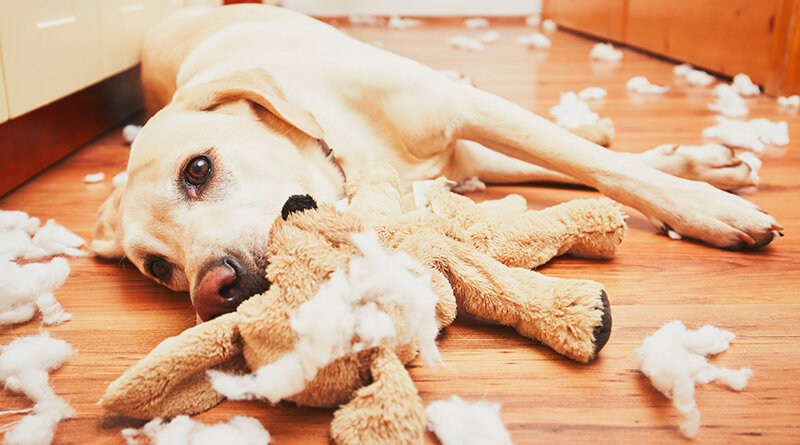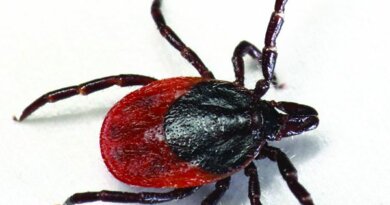What Did My Dog Just Eat?
Matthew McCarthy, DVM, owner of Juniper Valley Animal Hospital in Middle Village, Queens, N.Y., has removed many gastrointestinal foreign bodies (GIFBs—vet-speak for stuff that gets stuck in an animal’s stomach, intestines or colon) from dogs and cats. “For us vets, GIFBs are quite an exciting topic, kind of like party favors, as you never know what you will find,” says Dr. McCarthy. “Put a couple of vets together and bring up the topic of GIFBs, and the conversation will resemble the scene from the movie Jaws, where Quint, Brody and Hooper are trying to one-up each other on their various scars. Except for us, it’s the size, the amount and the strangeness of the object retrieved.”
Here are Dr. McCarthy’s thoughts about what dogs ingest, and how to keep them safe.
Q: What seems most appealing?
A: This could be anything, but for dogs, there may be a slight preference for items that are food-related (pork, beef or chicken bones) or those that just smell like food (kitchen rags, sink sponges, metallic food containers). Also, things that have the owner’s scent on them (think underwear or anything in a laundry basket). In cats, we see mostly string or hair (their own or a family member’s) gastrointestinal foreign bodies.
GET THE BARK IN YOUR INBOX!
Sign up for our newsletter and stay in the know.
Q: Have you been surprised by anything you’ve removed?
A: Dogs are definitely the worst offenders; cats are much more selective/picky. Lately, Apple Air Pods seem quite delicious, but we’ve retrieved remote controls (aka “the clicker”), infant pacifiers, Lego pieces of all sorts (actually, small kids’ toys in general), lipstick cases and batteries. Quite a few dogs seem proficient at removing the squeakers from plush toys and making a snack of them.
For cats, probably the most surprising obstruction is their own hair. One would assume that a cat is more than capable of grooming and dealing with its hair. However, there does seem to be a certain subset of cats who groom so obsessively that the amount of hair overwhelms their gastrointestinal tract to the point of obstruction.
Q: Why do you suppose dogs and cats do this?
A: Every time I remove a GIFB, I ask myself that question: What in the world would motivate this dog to eat this? Sure, dogs will often go for things that seem like food, but as for the other stuff, it’s anyone’s guess. I am not aware of any studies that have specifically looked at this, but it’s reasonable to assume that dogs who are bored or anxious may be more prone to destructive behaviors that may result in the inadvertent ingestion of indigestible items. Younger cats often ingest things they like to play with, such as thread, shirt buttons, catnip mouse toys and the like.
Some metabolic conditions, such as anemia or certain vitamin deficiencies, may cause both dogs and cats to want to ingest nonfood items. However, in those instances, they seem to go after more organic substances, such as dirt, cat litter, wood, gravel, grass or rocks. We refer to this condition as pica and it is quite different from the ingestion of man-made objects.
Q: Are certain dog breeds more likely than others to ingest objects?
A: Oh yeah! Big, goofy breeds such as Labradors and Golden Retrievers, as well as any combination of these, like Labradoodles and Golden Doodles.
Q: How do you know when to rush your pet to the vet?
A: The most obvious answer is if you see them ingest something (like the aforementioned sock). Depending on the item and a dog’s size and breed, if caught fairly soon, there is a good chance we can get him/her to vomit up the item. For those who come to us a little too late; have an object that is too big to vomit up; or, for breeds for whom it is not safe to induce vomiting (such as French or English Bulldogs, where the vomitus may wash back into their lungs, causing pneumonia), the “sooner the better” rule still applies.
If we can figure out what they ate and devise a plan for its retrieval, the less likely it is that they will need a more radical surgery and an extended stay in hospital. Unfortunately, most of our gastrointestinal foreign body patients present after several days of vomiting and anorexia [lack of appetite], with their owners unaware they have eaten anything of concern. These patients often need more complicated surgeries and have extended hospital stays.
Q: What does treatment cost?
A: This depends on two things: What they ate and when they ate it. For those who are rushed in because they were seen ingesting the object, inducing vomiting is quite cost-effective. Typically, treatment includes an exam, an injection to cause the vomiting and another to stop the vomiting. In our practice, this could be from around $125 to $200, depending on size (bigger dogs need more drugs).
If vomiting is not an option, then endoscopic retrieval, using a flexible tube with a light, camera and hook to grab the object and guide it back up through the esophagus and out the mouth may be an option. Like surgery, this procedure requires anesthesia; however, as it is a fairly rapid and non-invasive procedure, the cost is significantly less than surgery and a hospital stay—typically, in the range of several hundred dollars ($500 would be a good number).
In those cases where the owners are not aware that their pet ate anything and the patient presents with nonspecific signs of anorexia and vomiting, in addition to a physical exam, we perform various diagnostics, including, bloodwork; radiographs; and, in some cases, ultrasound of the gastrointestinal tract. These tests add to the overall cost. In addition, these are the cases more likely to require complicated/extensive surgeries and extended hospital stays.
At a general, non-specialty practice like ours, a straightforward gastrointestinal foreign body surgery without complications typically costs around $1,500 to $2,000. Complications could include the need to remove one or more sections of the intestine (called a resection and anastomosis) or to deal with widespread abdominal infection (peritonitis) from a ruptured intestine. If these are encountered, expect the cost to double or triple. In some cases, the foreign body will have caused so much damage that the surgery will need to be performed by a veterinary surgery specialist at a referral facility, in which case, the costs could exceed $5,000.
Q: What can we do to prevent dogs from swallowing dangerous objects?
A: For puppies, you really want to puppy-proof your house by keeping anything the pup can get in his mouth (keys, remote controls, rubber bands, hair ties and so forth) out of sight. If this isn’t possible, then confining the pup to one particular room, crate or kennel when he’s not being directly observed is fine. For those large, goofy breeds I mentioned before, such restrictions may need to go on well beyond puppyhood.
And be observant. If your dog has shown an inclination to tear apart and eat blankets or plush toys, do not allow him to have these items. Switch them out for chew-proof beds and food puzzles. Some of our patients who are repeat offenders (i.e., one or more instances of ingesting a foreign body) wear light basket muzzles most of the time.
The Safety List
On Walks
• Watch your dog, not your cell phone. Dogs will happily eat whatever they find—corn cobs, plastic food containers and more—while you’re scrolling or tweeting.
• Shorter leashes (four to six feet) are better; it’s difficult to see what your dog is doing 12 feet in front of you. By the time you notice, the offending object may have disappeared into his digestive tract.
• Carry treats to trade for non-edible objects.
• Consider a light basket muzzle if your dog is a known offender.
At Home: Dogs
• Inspect toys to make sure size and hardness are appropriate.
• Be careful with soft or plush chew toys (remember, squeakers are yummy).
• Puppy-proof your house: nothing mouth-sized within reach.
• For young dogs in particular, consider confinement to a safe-chew zone (an extra room, a large crate or kennel, or a playpen for smaller breeds).
At Home: Cats
• Regular brushing, especially for long-haired breeds (at least twice a week).
• Regular use of hairball preventives/lubricants such as Laxatone or Petromalt (flavored lubricants that soften and help prevent hairballs). Typically, a 1-inch strip twice a week is fine.
• Keep string or string-like objects away from kitties; sewing/knitting supplies should be stored in closed containers.
In General
• Contact your veterinarian immediately if you see your pet ingest something that seems concerning, or if your pet looks “off” or repeatedly vomits (especially after meals).
• Get pet insurance. Not only can it defray the costs involved in treating/removing GIFBs, it can be lifesaving.
• Think of your veterinarian and their team as partners in your pet’s health, and reach out to them with concerns and questions you may have about any aspect of your pet’s care.





Wonderful blog! I found it while searching on Yahoo News.
Do you have any suggestions on how to get listed in Yahoo
News? I’ve been trying for a while but I never seem to get there!
Many thanks
Hi there, I enjoy reading through your post. I wanted to write a little comment to support you.
Hello there, just became aware of your blog through Google, and found that it is
really informative. I’m going to watch out for brussels.
I will appreciate if you continue this in future.
A lot of people will be benefited from your writing. Cheers!
An intriguing discussion is definitely worth comment.
I think that you should write more about this topic, it might not be a taboo matter
but usually people don’t speak about such subjects.
To the next! Best wishes!!
Thanks , I have recently been looking for info about this topic for a while and yours is the best I have found out till now.
But, what about the conclusion? Are you certain concerning the source?
My family members all the time say that I am
wasting my time here at web, except I know I am getting familiarity daily by reading such
good content.
Hello my friend! I wish to say that this article is awesome, great written and come with approximately all significant
infos. I would like to look extra posts like this .
Hi there, all the time i used to check website posts here early in the daylight, for the reason that i like to
gain knowledge of more and more.
Hi, I wish for to subscribe for this blog to take newest updates, thus where can i
do it please help out.
I’d like to find out more? I’d love to find out
some additional information.
I like reading through an article that will make men and women think.
Also, many thanks for permitting me to comment!
After going over a few of the blog posts on your website, I
seriously appreciate your way of blogging. I bookmarked it to my bookmark site list
and will be checking back soon. Please visit
my website too and tell me how you feel.
Appreciate this post. Let me try it out.
Hi there I am so thrilled I found your site, I really found you by
mistake, while I was browsing on Aol for something else, Anyhow
I am here now and would just like to say kudos for a incredible post
and a all round enjoyable blog (I also love the theme/design), I don’t have
time to read through it all at the minute but I
have bookmarked it and also added in your RSS feeds,
so when I have time I will be back to read much more, Please do keep up the superb work.
Wonderful, what a web site it is! This weblog gives valuable
facts to us, keep it up.
Hi there it’s me, I am also visiting this site on a regular basis, this web
site is in fact pleasant and the people are in fact sharing
fastidious thoughts.
Hey! This post could not be written any better!
Reading this post reminds me of my previous room mate!
He always kept chatting about this. I will forward this write-up to him.
Fairly certain he will have a good read. Thanks for sharing!
dark web access onion market darknet market